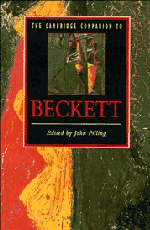Book contents
- Frontmatter
- 1 An endgame of aesthetics
- 2 Beckett's English fiction
- 3 Three novels and four nouvelles
- 4 Waiting for Godot and Endgame
- 5 Stages of identity
- 6 Beginning again
- 7 The mediated Quixote
- 8 Dead heads
- 9 Disabled figures
- 10 Beckett's poems and verse translations or
- 11 Beckett as director
- 12 Beckett's bilingualism
- 13 Beckett and the philosophers
- Further reading
- Index
1 - An endgame of aesthetics
Beckett as essayist
Published online by Cambridge University Press: 28 May 2006
- Frontmatter
- 1 An endgame of aesthetics
- 2 Beckett's English fiction
- 3 Three novels and four nouvelles
- 4 Waiting for Godot and Endgame
- 5 Stages of identity
- 6 Beginning again
- 7 The mediated Quixote
- 8 Dead heads
- 9 Disabled figures
- 10 Beckett's poems and verse translations or
- 11 Beckett as director
- 12 Beckett's bilingualism
- 13 Beckett and the philosophers
- Further reading
- Index
Summary
Whilst it is easy to see where Beckett's discursive writing begins, it is difficult to see where, or how, it ends. It is possible to outline the loose assemblage of aesthetic theories and philosophical ideas that form their point of departure, but it is extremely difficult to see what happens to these ideas and where they end up. Beckett's two major early essays, 'Dante...Bruno. Vico..Joyce' (1929) and Proust (1931) are founded upon fairly coherent systems of philosophy and aesthetics. The rest of his pre-war discursive writing, which consists mainly of short literary reviews, can with care be unpicked to reveal developments of the same ideas. After the war, Beckett's critical attention switched to painting. Despite their highly stylized manner and ironic tone, his first two essays are in many respects logical extensions of his pre-war ideas, and they can readily be labelled 'discursive'. Yet these pieces represent the start of a deconstructive process whose logical conclusion is not to be found in recognizably discursive writing at all, but in dramatized dialogue and in the condensed lyricism of the temoignages and later prose.
- Type
- Chapter
- Information
- The Cambridge Companion to Beckett , pp. 1 - 16Publisher: Cambridge University PressPrint publication year: 1994
- 5
- Cited by



